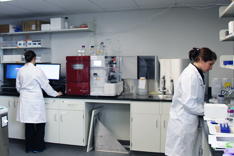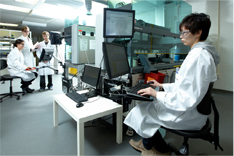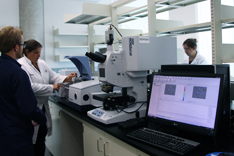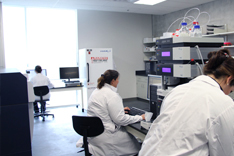About the Institute
The Biointerfaces Institute at McMaster University is a state-of-the-art facility implementing high-throughput research pipelines to investigate the nature of the biological/material interface, or biointerface.
The institute is led by Dr. John Brennan, Professor and Canada Research Chair in Bioanalytical Chemistry and Biointerfaces. Dr. Brennan is a world leader in the development of advanced sol-gel based biomaterials, biosensor technologies and high-throughput drug screening platforms.
The institute has ten additional core faculty members with expertise in high-throughput synthesis, surface characterization, polymer chemistry, bioassay development and opthalmic biomaterials, with backgrounds in Chemistry, Chemical Biology, Biochemistry, Chemical Engineering and Biomedical Engineering.
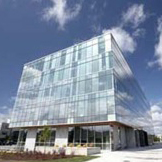


Our Facilities
Biological Preparation
The Biological Preparation Suite houses equipment for the preparation, purification, and analysis of biological agents and/or molecules.
Two separate cell culture laboratories, for either bacterial work (ETB 425) or mammalian work (ETB 420), are approved for Biosafety Level (BSL)-2 research. Each BSL-2 lab contains Class II Biological Safety Cabinets (BSC, NSF 49 certified), centrifuges, incubators, and other basic equipment necessary for cell culture. The bacterial culture lab also has a plate reader (Tecan M200) and a Fluorescent Activated Cell Sorter (FACS, Biorad Aria III). The mammalian culture lab additionally houses an automated mammalian cell counter (Invitrogen) and cryo-storage (Thermo Fisher). A third lab in the Biological Preparation suite (ETB 435), designated BSL-1, houses various equipment for media/supply sterilization, cell observation, disruption, ultracentrifugation, amplification, chromatography and analysis.
Synthesis and Screening
The Biointerfaces Institute houses a state-of-the-art high throughput synthesis facility to assist in the planning, development and implementation of projects relating to material synthesis and surface chemistry. The synthesis lab is home to advanced modular robotic workstations for high throughput assay development and optimization, and parallel synthesis of materials, small molecules and libraries of compounds, as well as more traditional custom synthesis. It also houses top-of-the-line contact and non-contact micro-arrayers and lateral flow dispensers for lab-on-a-chip and point of care diagnostic development, prototyping and scale up.
Surface Characterization
The Biointerfaces Institute houses a state-of-the-art surface characterization facility featuring an Imaging and Scanning X-ray Photoelectron Spectrometer Microprobe (PHI Quantera II) which allows for large and small area spectroscopy as well as high-throughput XPS on microarrays. Additionally, the facility houses a Vertex 70 FTIR Spectrometer with a Bruker Hyperion 3000 Infrared Microscope capable of performing point imaging as well as small area imaging, an Imaging Ellipsometer (Accurion), an Imaging Surface Plasmon Resonance instrument (Horiba) which allows for high-throughput data collection and analysis, a high speed Contact Angle instrument, and a Quartz Crystal Microbalance with Dissipation (Biolin Scientific) for studying molecular interactions and surface phenomena.
We also maintain a range of Zeta Potential and Particle Sizing Instruments: a ZetaProbe (Malvern) that uses NIBS technology with Dynamic Light Scattering, a Flow Path Imaging Analyzer (Malvern) for particle size and shape analysis, and a Focused Beam Reflective Measurer (Mettler Toledo) for cord length and kinetics of flocculation.
Bioselectivity
The Bioselectivity Suite includes a state-of-the-art mass spectrometry facility with an imaging MALDI mass spectrometer (Bruker UltrafleXtreme) capable of tissue and array imaging, a high resolution ESI-Q-TOF mass spectrometer (Bruker Maxis 4G) connected to a UHPLC (Dionex UltiMate 3000), as well as an ESI-ion trap mass spectrometer (Thermo LCQ Fleet). In addition, the suite includes two microscopes: an atomic force microscope (AFM, Bruker Bioscope Catalyst) specifically build to best answer the unique requirements of biologists, biophysicists, and bioengineers, as well as an inverted Eclipse Ti optical microscope fitted with a TIRF combo system with NSTORM capabilities (Nikon).
